Related Research Articles
A Usenet newsgroup is a repository usually within the Usenet system, for messages posted from users in different locations using the Internet. They are discussion groups and are not devoted to publishing news. Newsgroups are technically distinct from, but functionally similar to, discussion forums on the World Wide Web. Newsreader software is used to read the content of newsgroups. Before the adoption of the World Wide Web, Usenet newsgroups were among the most popular Internet services.

An email client, email reader or, more formally, message user agent (MUA) or mail user agent is a computer program used to access and manage a user's email.
The Great Renaming was a restructuring of Usenet newsgroups that took place in 1987. B News maintainer and UUNET founder Rick Adams is generally considered to be the initiator of the Renaming.
alt.religion.scientology was a Usenet newsgroup started in 1991 to discuss the controversial beliefs of Scientology and the activities of the Church of Scientology. The newsgroup became the focal point of an aggressive campaign known as Scientology versus the Internet, which took place online and in the courts.

A news server is a collection of software used to handle Usenet articles. It may also refer to a computer itself which is primarily or solely used for handling Usenet. Access to Usenet is only available through news server providers.

The alt.* hierarchy is a major class of newsgroups in Usenet, containing all newsgroups whose name begins with "alt.", organized hierarchically. The alt.* hierarchy is not confined to newsgroups of any specific subject or type, although in practice more formally organized groups tend not to occur in alt.*. The alt.* hierarchy was created by John Gilmore and Brian Reid.

B News was a Usenet news server developed at the University of California, Berkeley by Matt Glickman and Mary Ann Horton as a replacement for A News. It was used on Unix systems from 1981 into the 1990s and is the reference implementation for the de facto Usenet standard described in RFC 850 and RFC 1036. Releases from 2.10.2 were maintained by UUNET founder Rick Adams.

Sporgery is the disruptive act of posting a flood of articles to a Usenet newsgroup, with the article headers falsified so that they appear to have been posted by others. The word is a portmanteau of spam and forgery, coined by German software developer, and critic of Scientology, Tilman Hausherr.
X-No-Archive, also known colloquially as xna, is a newsgroup message header field used to prevent a Usenet message from being archived in various servers.
alt.sex is a Usenet newsgroup – a discussion group within the Usenet network – relating to human sexual activity. It was popular in the 1990s. An October 1993 survey by Brian Reid reported an estimated worldwide readership for the alt.sex newsgroup of 3.3 million, that being 8% of the total Usenet readership, with 67% of all Usenet "nodes" carrying the group. At that time, alt.sex had an estimated traffic of 2,300 messages per month.
Newsgroup spam is a type of spam where the targets are Usenet newsgroups. Usenet convention defines spamming as excessive multiple posting, i.e. repeated posting of a message or very similar messages to newsgroups. The spam may be commercial advertisements, opinionated messages, malicious files, or nonsensical posts designed to disrupt the newsgroups. A type of newsgroup spam is sporgery which is intended to make the targeted newsgroups unreadable. The prevalence of Usenet spam led to the development of the Breidbart Index as an objective measure of a message's "spamminess", and attempts to purge newsgroups of spam.
When a message is replied to in e-mail, Internet forums, or Usenet, the original can often be included, or "quoted", in a variety of different posting styles.
The Breidbart Index, developed by Seth Breidbart, is the most significant cancel index in Usenet.
NOV, or News Overview, is a widely deployed indexing method for Usenet articles, also found in some Internet email implementations. Written in 1992 by Geoff Collyer, NOV replaced a variety of incompatible indexing schemes used in different client programs, each typically requiring custom modifications to each news server before they could be used. In modern NNTP implementations, NOV is exposed as the XOVER and related commands.
Usenet II was a proposed alternative to the classic Usenet hierarchy, started in 1998. Unlike the original Usenet, it was peered only between "sound sites" and employed a system of rules to keep out spam.
The Big 8 are a group of newsgroup hierarchies established after the Great Renaming, a restructuring of Usenet that took place in 1987. These hierarchies are managed by the Big 8 Management Board. Groups are added through a process of nomination, discussion and voting.

Conversation threading is a feature used by many email clients, bulletin boards, newsgroups, and Internet forums in which the software aids the user by visually grouping messages with their replies. These groups are called a conversation, topic thread, or simply a thread. A discussion forum, e-mail client or news client is said to have a "conversation view", "threaded topics" or a "threaded mode" if messages can be grouped in this manner. An email thread is also sometimes called an email chain.
A Usenet personality was a particular kind of Internet celebrity, being an individual who gained a certain level of notoriety from posting on Usenet, a global network of computer users with a vast array of topics for discussion. The platform is usually anonymous, although users can get celebrity status, usually by being deemed different from other posters in some way.

Usenet, USENET, or, "in full", User's Network, is a worldwide distributed discussion system available on computers. It was developed from the general-purpose Unix-to-Unix Copy (UUCP) dial-up network architecture. Tom Truscott and Jim Ellis conceived the idea in 1979, and it was established in 1980. Users read and post messages to one or more topic categories, known as newsgroups. Usenet resembles a bulletin board system (BBS) in many respects and is the precursor to the Internet forums that have become widely used. Discussions are threaded, as with web forums and BBSes, though posts are stored on the server sequentially.
The Meow Wars were an early example of a flame war sent over Usenet which began in 1996 and ended circa 1998. Its participants were known as "Meowers". The war was characterized by posters from one newsgroup "crapflooding", or posting a large volume of nonsense messages, to swamp on-topic communication in other groups. Ultimately, the flame war affected many boards, with Roisin Kiberd writing in Motherboard, a division of Vice, that esoteric Internet vocabulary was created as a result of the Meow Wars.
References
- ↑ InterNetNews never supported all.all.ctl[ clarification needed ]. INN version 1.0 was released in 1990.
- ↑ "Subject: cmsg" is described only in RFC 1036 (published in December 1987) but not in RFC 850 (published in June 1983). INN dropped this feature with version 2.3. See INN Changes and Upgrade Information (Internet Archive).
- ↑ RFC 5537, 5. Control Messages: [...] The presence of a Subject header field starting with the string "cmsg " MUST NOT cause an article to be interpreted as a control message. [...] Likewise, the presence of a <newsgroup-name> ending in ".ctl" in the Newsgroups header field or the presence of an Also-Control header field MUST NOT cause the article to be interpreted as a control message.
- ↑ RFC 850 uses the term "local super user" instead of "local news administrator". Son-of-RFC-1036 (this is the colloquial name of an Internet Draft written by Henry Spencer) drops the administrator's cancel altogether. The problem with the verification scheme is that the From: line is trivial to forge and with cancelbots the cancel message often arrives before the target article. Option verifycancels of INN defaults to false.
- ↑ Section 5.2.1. of RFC 5537 says: The newgroup control message requests that the specified group be created or, if already existing, that its moderation status or description be changed. The feature is much older, though. For example the manual page of the ctlinnd utility (part of INN) says: If the newsgroup already exists, this is equivalent to the changegroup command.
- ↑
- How To Write a Good Newgroup Message Archived 2008-04-15 at the Wayback Machine
- How to create an ALT newsgroup
- free.* FAQ Archived 2008-03-15 at the Wayback Machine
- 1 2 Regeln für die Einrichtung, Änderung und Entfernung von Usenet-Gruppen
- 1 2 ftp://ftp.isc.org/pub/usenet/control/
- ↑ Section "3.5. Sendsys" of RFC 1036 includes the following clause: This information is considered public information, and it is a requirement of membership in USENET that this information be provided on request, either automatically in response to this control message, or manually, by mailing the requested information to the author of the message.
- ↑ RFC 1036, sections "3.3. Newgroup" and "3.4. Rmgroup". Section "3.7. Checkgroups" does not contain this clause.
- ↑ RFC 822, published in August 1982
- ↑ RFC 1036, section "2. Message Format"
- ↑ RFC 2822, obsoleted RFC 822 in April 2001
- ↑ INN already ships with pgpcontrol. The project site ftp://ftp.isc.org/pub/pgpcontrol/ additionally provides instructions on how to set up PGP/OpenPGP and a huge archive of hierarchy keys.
- ↑ Cancel-Locks in Usenet articles: draft-ietf-usefor-cancel-lock-01.txt, published in November 1998, expired in May 1999
- ↑ INN normally files control messages to the pseudo newsgroup control. However, if a subgroup of control exists that matches the control command, the control message will be filed into that group instead.
- ↑ ftp://ftp.isc.org/pub/usenet/control/other.ctl/